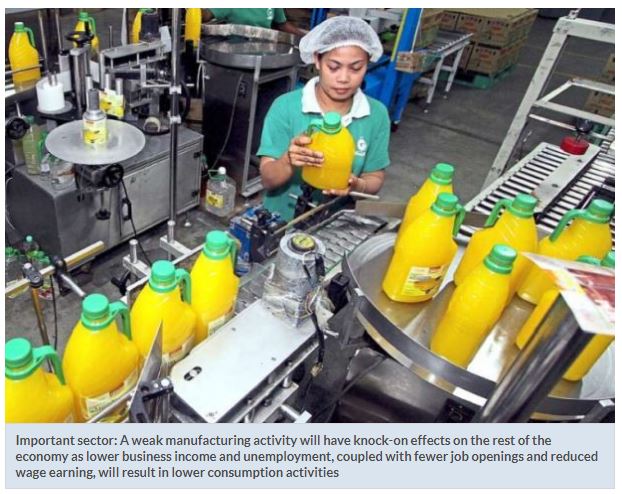Malaysia: Hazy outlook for manufacturing in Q4
PETALING JAYA: The country’s manufacturing activity in the fourth quarter of the year (4Q20) could slow further as fears of a new wave of Covid-19 transmissions could affect factory operations and see delays in investment decisions.
In September, the Purchasing Managers’ Index (PMI), an indicator of the economic health of the manufacturing sector, remained in the contraction region for the third consecutive month with a reading at 49.
This was due to weak domestic and export orders.
A PMI above 50 represents an expansion when compared with the previous month while a reading under 50 represents a contraction. The PMI for August stood at 49.3.
AmBank Group chief economist Anthony Dass said the outlook for the 4Q20 would depend much on the severity of the second wave of the pandemic virus.
“Uncertainties remain. Hence, firms are scaling back on employment and capacity. A couple of domestic factors from politics to worry of defaults post loan moratorium could have some knock-on effects on business sentiment, ” he said when contacted.
Sunway University professor of economics Yeah Kim Leng said September’s PMI is a bit of a concern, though not surprising because many countries are either still struggling to contain the pandemic or facing a resurgence threat, as in the case of Malaysia.
“The decline in economic activities suggested by the PMI is reflective of slumping global demand from either weak recovery or continuing recession faced by Malaysia’s key trading partners, ” he told StarBiz.
According to Yeah, the declining PMI trend is confirmed by coincident indicators such as the latest August’s 4.6% drop in Malaysia’s total trade.
As for exports, it fell by 2.9% in August following two consecutive months of increases after a more than 20% plunge in exports at the peak of the pandemic impact in April and May.
While businesses are struggling to financially maintain their business operations, input cost rose for the fourth consecutive month in September on raw material shortages and higher price of imported items amid shipping issues following the reinstatement of movement restrictions in some countries.
Despite this, selling prices only increased marginally as sellers were unable to raise prices as much given a weak demand condition.
Within Asean, other countries also saw an easing in manufacturing activity in September with the exception of Vietnam and Philippines, which registered modest expansion. “Without a sustained pickup in domestic and external demand, manufacturing activity and the PMI will remain weak in the coming months, leading to a more uneven recovery, ” Yeah added.
A weak manufacturing activity will have knock-on effects on the rest of the economy as lower business income, unemployment, coupled with fewer job openings and reduced wage earnings will result in lower consumption activities.
Yeah said households in the country will likely turn more cautious if the virus infections continue to rise and some form of movement control order is re-imposed for the hot spot areas.
However, economists believe another stimulus package may be premature at this stage.
AmBank’s Dass said last month’s additional RM10bil stimulus measures, which have brought the total direct and indirect stimulus to RM305bil, should provide some cushioning on the downside risk to the economy.
However, should the PMI deteriorate further and in the unlikely situation of a movement control order (MCO), another round of fiscal stimulus may be required.
Until then, it is prudent to preserve the fiscal bullets for a crisis event, economists said.
A nationwide MCO is an unlikely scenario reckon some analysts.
Closure of business operations would once again hurt companies, particularly the small and medium sized enterprises, which are already facing difficulty keeping their workers due to depleting cash flows and weaker sales.
A more likely scenario would be the imposition of a localised or targeted enhanced MCO (TEMCO).
Even so, MIDF Research said that a TEMCO imposed in Selangor or the Klang Valley, where numbers of Covid-19 cases have been on the rise, would have an adverse impact on the the coutry’s economy.
By economic size, Selangor, Kuala Lumpur and Putrajaya contribute approximately 40% of Malaysia’s gross domestic product (GDP), according to the research firm.
Assuming a month-long TEMCO in Klang Valley, MIDF estimates that the impact to Malaysia’s economy could reach up to RM28.8bil in output loss (or -1.9% of GDP) from a fall in aggregate demand.
On the assumption that this potential TEMCO were to be as strict as the MCO during the first Covid-19 wave, MIDF said that the decline in the country’s economic growth could come in worse, with GDP estimated to contract at a steeper pace of 6.7% versus its current projection of minus 4.8% for 2020.
The World Bank recently lowered its 2020 economic growth forecast for Malaysia to a contraction of 4.9% from its earlier estimate of a 3.1% decline.
This came after Malaysia registered a sharper-than-expected GDP contraction in the 2Q20 due to the impact of Covid-19.
The Malaysian economy contracted by 8.3% in the first half of 2020.
Source: https://www.thestar.com.my/business/business-news/2020/10/05/hazy-outlook-for-manufacturing-in-q4


 Thailand
Thailand





